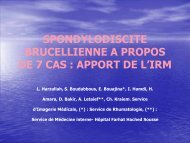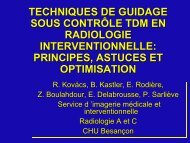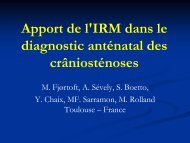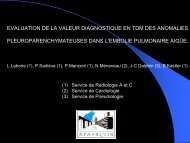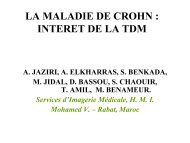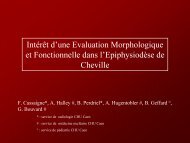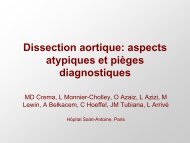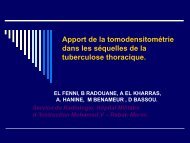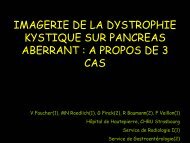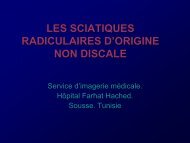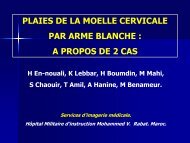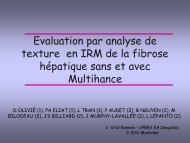Intérêt de l'Arthroscopie Virtuelle de l'épaule et du genou chez le ...
Intérêt de l'Arthroscopie Virtuelle de l'épaule et du genou chez le ...
Intérêt de l'Arthroscopie Virtuelle de l'épaule et du genou chez le ...
Create successful ePaper yourself
Turn your PDF publications into a flip-book with our unique Google optimized e-Paper software.
Intérêt <strong>de</strong> l’Arthroscopie<br />
l<br />
<strong>Virtuel<strong>le</strong></strong> <strong>de</strong> l’él<br />
’épau<strong>le</strong> <strong>et</strong> <strong>du</strong><br />
<strong>genou</strong> <strong>chez</strong> <strong>le</strong> sportif<br />
F Walter (1,2) , Ch Nuehrenboerger (3) ,<br />
P Page (2) , JF Calafat (2) , J Vuil<strong>le</strong>min (2) , R Seil (4)<br />
(1) Service d’Imagerie Guilloz - Pr.A.Blum - CHU Nancy – France<br />
(2) Service d’Imagerie Médica<strong>le</strong> – CHL – Clinique d’Eich – Luxembourg<br />
(3) Service <strong>de</strong> Mé<strong>de</strong>cine <strong>du</strong> Sport - CHL – Clinique d’Eich – Luxembourg<br />
(4) Service <strong>de</strong> Chirurgie Orthopédique - CHL - Clinique d’Eich – Luxembourg
But<br />
<br />
Montrer <strong>et</strong> illustrer l’intl<br />
intérêt <strong>de</strong><br />
l’arthroscopie virtuel<strong>le</strong> en arthroscanner<br />
avant chirurgie arthroscopique <strong>de</strong><br />
l’épau<strong>le</strong> <strong>et</strong> <strong>du</strong> <strong>genou</strong> <strong>chez</strong> <strong>le</strong> sportif
Matériels <strong>et</strong> Métho<strong>de</strong>sM<br />
<br />
<br />
<br />
30 patients (18 hommes, 12 femmes), <strong>de</strong><br />
17 à 66 ans (âge moyen : 35,8 ans)<br />
Sportifs (amateur ou professionnel)<br />
Bilan pré arthroscopique<br />
<br />
<br />
Arthroscanner <strong>du</strong> <strong>genou</strong> : 16 patients<br />
Arthroscanner <strong>de</strong> l’él<br />
’épau<strong>le</strong> : 14 patients
Matériels <strong>et</strong> Métho<strong>de</strong>sM<br />
<br />
Technique habituel<strong>le</strong> d’arthrographie d<br />
en<br />
contraste simp<strong>le</strong><br />
<br />
<br />
Volume injecté : 10ml pour <strong>le</strong>s épau<strong>le</strong>s; 20ml<br />
pour <strong>le</strong>s <strong>genou</strong>x (Hexabrix 320, Guerb<strong>et</strong>)<br />
Réalisation d’une d<br />
arthrographie numéris<br />
risée<br />
au décours d<br />
(inci<strong>de</strong>nces classiques)
Matériels <strong>et</strong> Métho<strong>de</strong>sM<br />
<br />
Arthroscanner volumique<br />
<br />
<br />
<br />
<br />
Collimation <strong>de</strong> 6*0.5mm (Emotion 6, Siemens AG)<br />
Reconstruction 0.63/0.30, filtres os <strong>et</strong><br />
standard<br />
Reconstructions MPR os sagitta<strong>le</strong>s <strong>et</strong><br />
corona<strong>le</strong>s systématiques<br />
Reconstructions 3D arthroscopiques<br />
virtuel<strong>le</strong>s
Matériels <strong>et</strong> Métho<strong>de</strong>sM<br />
<br />
Interprétation tation <strong>de</strong>s images sur conso<strong>le</strong><br />
dédiée (Leonardo 2006, Siemens AG)<br />
<br />
<br />
<br />
Logiciels « In Space » <strong>et</strong> « 3D Fly Through »<br />
avec optimisation <strong>de</strong>s paramètres <strong>de</strong><br />
seuillage<br />
Paramètres<br />
étudiés s :<br />
Cartilage : topographie, tail<strong>le</strong>, profon<strong>de</strong>ur (gra<strong>de</strong>s 2<br />
(gra<strong>de</strong>s 2-4<br />
selon la classification modifiée e d’Outerbridge d<br />
<strong>et</strong> Noyes)<br />
Ménisque : type fissuraire, topographie, extension
Matériels <strong>et</strong> Métho<strong>de</strong>sM<br />
<br />
<br />
<br />
Paramètres<br />
étudiés s :<br />
Rupture tendineuse : topographie, tail<strong>le</strong>,<br />
extension<br />
Labrum : topographie, extension, gra<strong>de</strong> (si SLAP)<br />
Comparaison aux données arthroscopiques<br />
avec évaluation par test <strong>de</strong> concordance<br />
(Coefficient Kappa <strong>de</strong> Cohen)<br />
Corrélation<br />
à l’IRM si disponib<strong>le</strong>
Résultats<br />
<br />
<br />
<br />
<br />
Epau<strong>le</strong>s : 8 ruptures <strong>de</strong> coiffe, 4 fissures<br />
labra<strong>le</strong>s, 2 lésions l<br />
cartilagineuses<br />
Genoux : 10 lésions l<br />
cartilagineuses, 8 fissures<br />
ménisca<strong>le</strong>s<br />
La concordance entre l’arthroscannerl<br />
<strong>et</strong><br />
l’arthroscopie chirurgica<strong>le</strong> était bonne à<br />
excel<strong>le</strong>nte (K=0.72 à 1).<br />
De plus, il existait une bonne concordance<br />
« lésionnel<strong>le</strong><br />
» subjective entre <strong>le</strong>s images 3D<br />
arthroscopiques <strong>et</strong> l’arthroscopie l<br />
réel<strong>le</strong>. r
Cas 1 : M. B.A, 26 ans, footbal<strong>le</strong>ur professionnel.<br />
Traumatisme indirect 15 jours auparavant avec dou<strong>le</strong>urs <strong>et</strong><br />
épiso<strong>de</strong> d’hydarthrose.<br />
d<br />
IRM : courtoisie <strong>du</strong> Dr.Y Lasar-CHL
Cas 1 : M. B.A<br />
Diagnostic ?<br />
Ulcération cartilagineuse postérieure <strong>du</strong> condy<strong>le</strong><br />
externe <strong>de</strong> 1cm gra<strong>de</strong> 4 avec langu<strong>et</strong>te libre
Cas 2 : M. M.E, 58 ans, dou<strong>le</strong>urs persistantes <strong>du</strong> <strong>genou</strong> gauche<br />
6 mois après s entorse lors <strong>de</strong> la pratique <strong>de</strong> sport en loisirs.<br />
Diagnostic ? Fissure dilacération <strong>de</strong>s portions moyenne <strong>et</strong> postérieure<br />
<strong>du</strong> ménisque m<br />
interne, chondropathie gra<strong>de</strong> 2-32
Cas 3 : M. R.G, 22 ans, sportif régulier, r<br />
luxations antérieures<br />
récidivantes <strong>de</strong> l’él<br />
’épau<strong>le</strong> gauche<br />
Diagnostic ?<br />
Fissure <strong>et</strong> décol<strong>le</strong>ment d<br />
<strong>du</strong> labrum antérieur <strong>et</strong> inférieur
Cas 4 : M. S.R, 44 ans, <strong>de</strong>ntiste <strong>et</strong> sportif, épau<strong>le</strong> gauche<br />
douloureuse chronique<br />
Diagnostic ?<br />
IRM : courtoisie <strong>du</strong> Dr.Y Lasar-CHL<br />
Chondropathie gra<strong>de</strong> 3 <strong>de</strong> la tête huméra<strong>le</strong> gauche
Cas 5 : M. A.D.S, 22 ans, footbal<strong>le</strong>ur amateur, dou<strong>le</strong>ur <strong>et</strong> blocage<br />
compl<strong>et</strong> <strong>du</strong> <strong>genou</strong> droit suite à un match<br />
Diagnostic ? Fissure complète <strong>du</strong> ménisque m<br />
interne avec luxation en<br />
anse <strong>de</strong> seau plaquée e contre <strong>le</strong> LCA
Cas 6 : M. MM, 28 ans, sportif régulier r<br />
(bask<strong>et</strong>), dou<strong>le</strong>urs<br />
fémoro-patellaires chroniques<br />
Diagnostic ?<br />
Ulcération cartilagineuse gra<strong>de</strong> 2-32<br />
3 avec<br />
langu<strong>et</strong>te libre <strong>de</strong> la face média<strong>le</strong> m<br />
<strong>de</strong> la patella
Cas 7 : M. A.J, 30 ans, dou<strong>le</strong>urs fémorof<br />
moro-tibia<strong>le</strong>s internes suite à<br />
une entorse <strong>du</strong> <strong>genou</strong> droit au football il y a <strong>de</strong>ux mois<br />
Diagnostic ?<br />
Lésion ostéo-chondra<strong>le</strong> (gra<strong>de</strong> 4)<br />
antérieure <strong>du</strong> condy<strong>le</strong> interne
Cas 8 : M. F.M, 28 ans, dou<strong>le</strong>urs persistantes après s entorse au<br />
football il y a 3 semaines <strong>et</strong> évacuation d’une d<br />
hémarthrose<br />
h<br />
a. Vue face supérieure ME<br />
b. Vue bord libre ME
Cas 8 : M. F.M, 28 ans, dou<strong>le</strong>urs persistantes après s entorse au<br />
football il y a 3 semaines <strong>et</strong> évacuation d’une d<br />
hémarthrose h<br />
(suite)<br />
c. Vue bord périphp<br />
riphérique rique ME<br />
d. Vue face inférieure ME<br />
Diagnostic ?<br />
Fissure longitudina<strong>le</strong> transfixiante <strong>de</strong>s portions<br />
postérieure <strong>et</strong> moyenne <strong>du</strong> ME
Cas 9 : Ml<strong>le</strong> T.N., 26 ans, bask<strong>et</strong>teuse <strong>de</strong> haut niveau, dou<strong>le</strong>urs<br />
fémoro-patellaires chroniques<br />
Diagnostic ?<br />
Ulcérations cartilagineuses en franges gra<strong>de</strong> 3 <strong>de</strong> la<br />
face latéra<strong>le</strong> <strong>de</strong> la patella
Discussion<br />
<br />
<br />
<br />
Notre étu<strong>de</strong> confirme la bonne concordance entre<br />
l’arthroscanner <strong>et</strong> l’arthroscopie l<br />
chirurgica<strong>le</strong> déjàd<br />
démontrée<br />
par d’autres d<br />
auteurs<br />
L’interprétation tation d’un d<br />
examen nécessite n<br />
bien enten<strong>du</strong><br />
systématiquement l’analyse l<br />
<strong>de</strong>s images multiplanaires, axia<strong>le</strong>s,<br />
sagitta<strong>le</strong>s, fronta<strong>le</strong>s <strong>et</strong> éventuel<strong>le</strong>ment obliques.<br />
Notre série s<br />
m<strong>et</strong> en va<strong>le</strong>ur l’intl<br />
intérêt additionnel <strong>de</strong>s<br />
reconstructions 3D arthroscopiques virtuel<strong>le</strong>s pour visualiser <strong>le</strong>s<br />
lésions :<br />
<br />
<br />
<br />
<br />
<br />
Visualisation globa<strong>le</strong> <strong>de</strong> la lésionl<br />
Visualisation <strong>de</strong> la lésion l<br />
dans l’espace l<br />
dans <strong>de</strong>s conditions similaires<br />
à cel<strong>le</strong>s <strong>de</strong> l’arthroscopie l<br />
chirurgica<strong>le</strong><br />
Navigation intra articulaire similaire à cel<strong>le</strong> <strong>de</strong> la chirurgie possib<strong>le</strong><br />
Accessibilité à <strong>de</strong>s ang<strong>le</strong>s <strong>de</strong> vue originaux pour apprécier<br />
l’extension lésionnel<strong>le</strong>l<br />
Toutes <strong>le</strong>s structures intra articulaires peuvent être approchées
Discussion<br />
<br />
Limites <strong>de</strong> l’arthroscopie l<br />
virtuel<strong>le</strong><br />
<br />
<br />
<br />
<br />
Nécessité d’une qualité arthrographique optima<strong>le</strong> avec bonne<br />
distension <strong>de</strong>s récessus r<br />
<strong>et</strong> <strong>de</strong>s espaces articulaires<br />
Nécessité d’une qualité d’image optima<strong>le</strong> en arthroscanner<br />
La qualité <strong>de</strong>s images <strong>et</strong> <strong>le</strong>ur bonne exploitation dépen<strong>de</strong>nt d<br />
<strong>de</strong>s<br />
paramètres <strong>de</strong> seuillage usités s qui doivent impérativement être<br />
optimisés s sur <strong>le</strong>s images 3D surfaciques<br />
Certaines zones articulaires peuvent être d’exploration d<br />
diffici<strong>le</strong> :<br />
interligne articulaire très s fin, mauvais déploiement d<br />
<strong>de</strong>s récessus r<br />
articulaires<br />
<br />
Notons que notre série s<br />
ne comportait pas <strong>de</strong> cas <strong>de</strong> rupture<br />
ligamentaire.
Discussion<br />
<br />
<br />
<br />
<br />
Les images 3D d’arthroscopie d<br />
virtuel<strong>le</strong> sont au mieux visualisées<br />
en mo<strong>de</strong> ciné interactif avec navigation contrôlée e par l’opl<br />
opérateur<br />
Ces reconstructions 3D perm<strong>et</strong>tent d’avoir d<br />
une approche plus<br />
« réaliste<br />
» <strong>de</strong>s lésions l<br />
intra articulaires<br />
Ces images perm<strong>et</strong>tent au chirurgien d’anticiper, d<br />
voire <strong>de</strong><br />
planifier ou <strong>de</strong> gui<strong>de</strong>r son geste arthroscopique<br />
Ce mo<strong>de</strong> <strong>de</strong> reconstruction d’images d<br />
peut en outre revêtir un<br />
intérêt pédagogiquep
Conclusion<br />
<br />
L’arthroscopie virtuel<strong>le</strong> en arthroscanner<br />
est une métho<strong>de</strong> m<br />
<strong>de</strong> reconstruction 3D<br />
innovante pouvant être uti<strong>le</strong> dans <strong>le</strong> bilan<br />
avant chirurgie arthroscopique <strong>du</strong> <strong>genou</strong> ou<br />
<strong>de</strong> l’él<br />
’épau<strong>le</strong> <strong>chez</strong> <strong>le</strong> sportif<br />
Merci pour votre attention
Références<br />
• A Blum, L Feldmann, F Bres<strong>le</strong>r, P Jouanny, S Briançon, D Régent. R<br />
Intérêt <strong>du</strong> calcul <strong>du</strong> coefficient Kappa dans<br />
l’évaluation d’une d<br />
métho<strong>de</strong> m<br />
d’imagerie. d<br />
J Radiol 1995; 7 : 441-3.<br />
• JG Cha, , KD Min, SH Paik, SJ Park, DH Kim, , HK Lee. 16 slice multi<strong>de</strong>tector CT virtual arthroscopy : application to<br />
labral <strong>le</strong>sions of shoul<strong>de</strong>r joint. RSNA 2005<br />
• M Hadj-Salah<br />
Salah, , S Mourali, , MA Ab<strong>de</strong>lali, , K Meliani, , M Ben Mrad, , D Cyrine, , MH Bouhaouala. . Spiral computed<br />
tomographic (CT) arthrography versus arthroscopy in internal <strong>de</strong>rangements of the knee. . Tunis Med 2006; 84 :<br />
734-7<br />
• K Irie, , T Yamada. Three-dimensional<br />
virtual computed tomography imaging for injured anterior cruciate ligament.<br />
Arch Orthop Trauma Surg 2002; 122 : 93-5.<br />
• FE Lecouv<strong>et</strong>, , B Dorzée, , JE Dubuc, , BC Van<strong>de</strong> Berg, J Jamart, , J Malghem. . Cartilage <strong>le</strong>sions of the g<strong>le</strong>no-humeral<br />
joint : diagnostic effectiveness of multi<strong>de</strong>tector spiral CT arthrography and comparison with arthroscopy. Eur<br />
Radiol 2007; 17 : 1763-71.<br />
71.<br />
• W Lee, HS Kim, , SJ Kim, , S Hong, , J Chung. Various diagnostic tips and pitfalls in CT arthrography and virtual<br />
arthroscopy of the knee joint. RSNA 2003<br />
• W Lee, HS Kim, , SJ Kim, , HH Kim, , JW Chung, , HS Kang, , SH Hong, , JY Choi. . CT arthrography and virtual arthroscopy<br />
in the diagnosis of the anterior cruciate ligament and meniscal abnormalities of the knee joint. Korean J Radiol<br />
2004; 5 : 47-54.<br />
• FR Noyes, , CL Stab<strong>le</strong>r. . A system for grading articular cartilage <strong>le</strong>sions at arthroscopy. Am J Sports Med 1989; 17 :<br />
505-13<br />
• E Pessis, , F Bach, JL Drape, L Meziti, , H Guerini, , A Chevrot. Virtual Arthroscopy applied to CT-arthrography<br />
of the<br />
knee : evaluation for <strong>de</strong>tecting meniscal tears. . RSNA 2003<br />
• G Sahin, , BE Dogan, , M Demirtas. Virtual Arthroscopy of the wrist joint : a new intraarticular perspective. Skel<strong>et</strong>al<br />
Radiology 2004; 33 : 9-14. 9<br />
• BC Van<strong>de</strong> Berg, FE Lecouv<strong>et</strong>, , P Poilvache, , JE Dubuc, , B Maldague, , J Malghem. Anterior cruciate ligament tears and<br />
associated meniscal <strong>le</strong>sions : assessment at <strong>du</strong>al-<strong>de</strong>tector<br />
<strong>de</strong>tector spiral CT arthrography. Radiology 2002; 223 : 403-9.<br />
• F Walter, T Ludig, , S Iochum, , A Blum. Multi-<strong>de</strong>tector<br />
CT in musculo-skel<strong>et</strong>al<br />
skel<strong>et</strong>al disor<strong>de</strong>rs. JBR-BJR<br />
BJR 2003 ; 86 : 6-14. 6<br />
• D Weishaupt, , S Wil<strong>de</strong>rmuth, , M Schmid, , PR Hilfiker, , J Hod<strong>le</strong>r, JF Debatin. Virtual MR arthroscopy : new insights<br />
into joint morphology. . J Magn Reson Imaging 1999; 9 : 757-60.<br />
• CZ Xiong, , JM Hao. . Spiral CT arhrography of multiplanar reconstruction and virtual arthroscopy technique in<br />
diagnosis of knee with internal <strong>de</strong>rangements. Chin J Traumatol 2004; 7 : 108-12<br />
12




